The term “rose mosaic” may sound like a good thing. Maybe you imagine it denoting an artistic way to display particularly pretty blossoms, for example. But boy are you in for a surprise if this sounds like you.
Rose mosaic sucks. It does cause some interesting patterns in the leaves and flower petals of Rosa species, but it also causes these plants to fail to bloom, and can even contribute to their demise. Oh, and there is no cure.
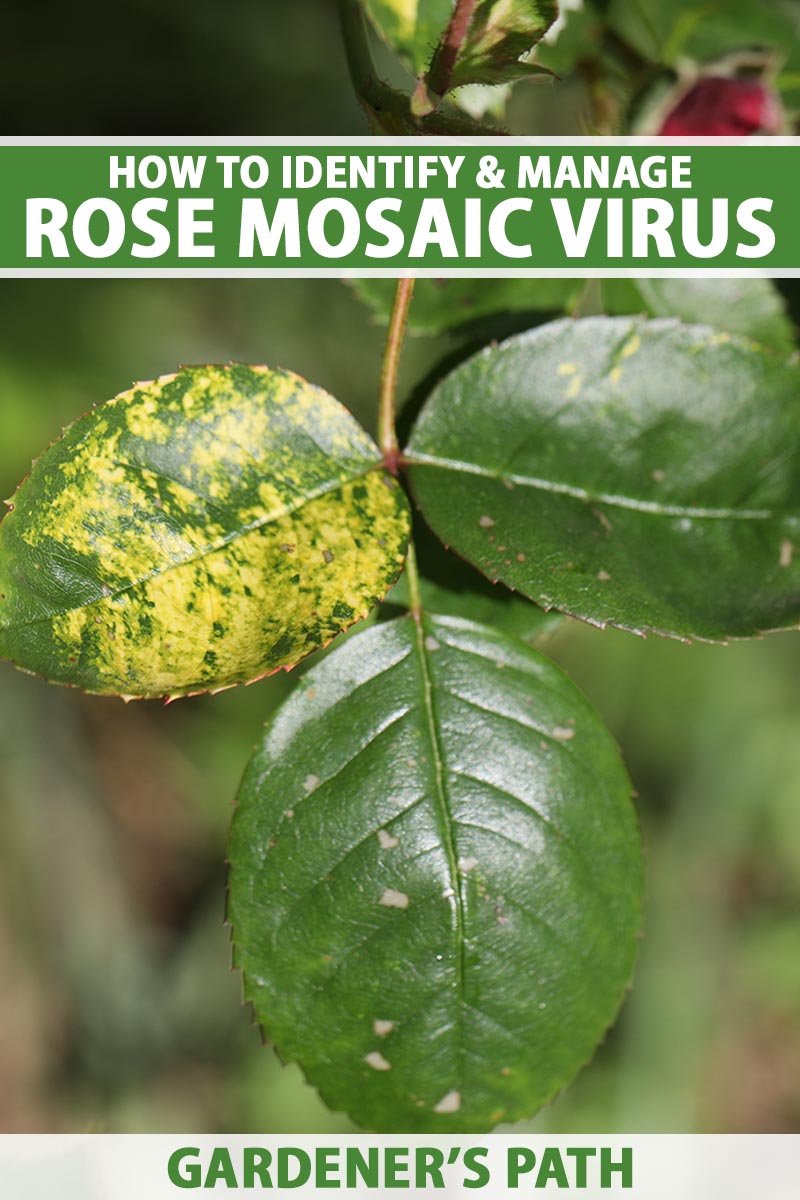
We link to vendors to help you find relevant products. If you buy from one of our links, we may earn a commission.
So, yeah. Not a good thing at all.
Don’t panic. You aren’t completely at the mercy of this widespread viral disease. We’re going to arm you so you know what to look for and what to do if this problem comes to visit.
Up ahead, here’s what we’ll discuss:
What You’ll Learn
A little knowledge can go a long way towards limiting the damage that diseases can do in your garden. With that in mind, let’s dig in.
What Is Rose Mosaic Virus?
What we refer to as rose mosaic is actually several different viral diseases.
Roses can be infected by apple mosaic virus (ApMV), Arabis mosaic virus (ArMV), and Prunus necrotic ringspot virus (PNRSV). Collectively, we call these Rose Mosaic Virus Complex (RMVc).
It doesn’t matter which virus is causing the problem or if all three have attacked your plant at once. The symptoms are similar and the treatment is the same, so don’t get hung up on figuring out which is which.
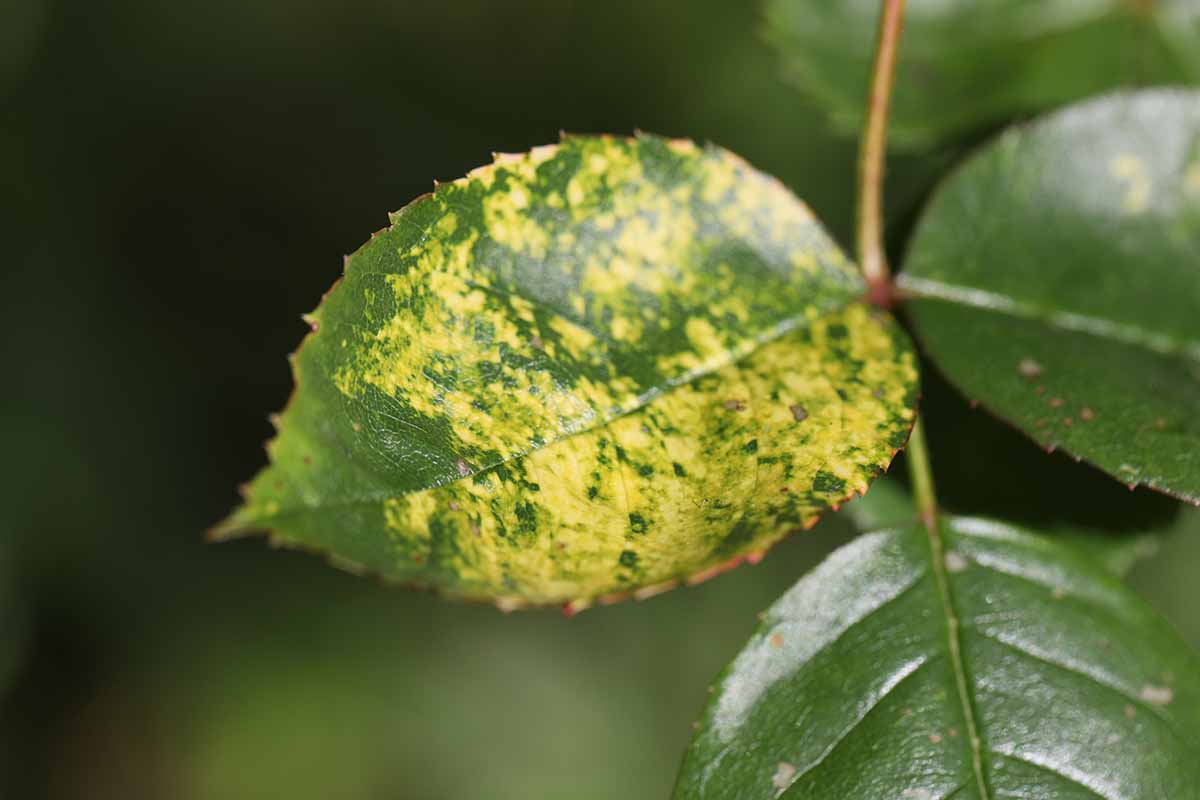
This is one of the most common diseases of roses in North America, so don’t panic if you find it in your garden. It happens to all of us at some point.
Symptoms
Sometimes RMVc is as obvious as a big neon sign blinking “mosaic virus ahead.” And sometimes it’s much more difficult to diagnose.
The symptoms are mottled leaves and foliage with yellow circles, lines, zig-zags, or patches. Sometimes you’ll even see squiggly yellow lines, and these look a lot like some sort of insect damage.
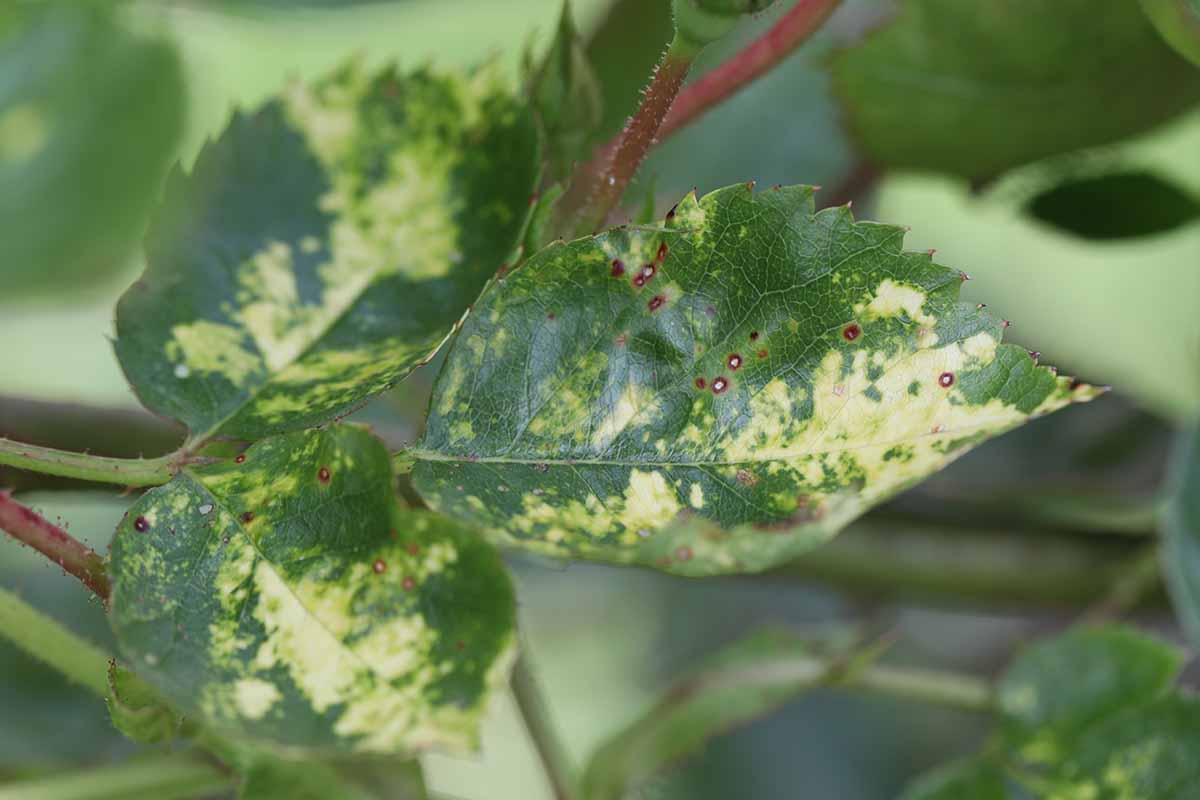
You might also see watermarking, which is a faint yellow swirl, or an oak-leaf pattern, with a shape similar to the leaves of those well-known trees. The flower petals can also be mottled.
You can tell the viral disease apart from other diseases that cause similar symptoms in a few ways.
Symptoms usually show up in the spring though they may sometimes appear in fall. The impacted growth is often covered up by new foliage as the season progresses.
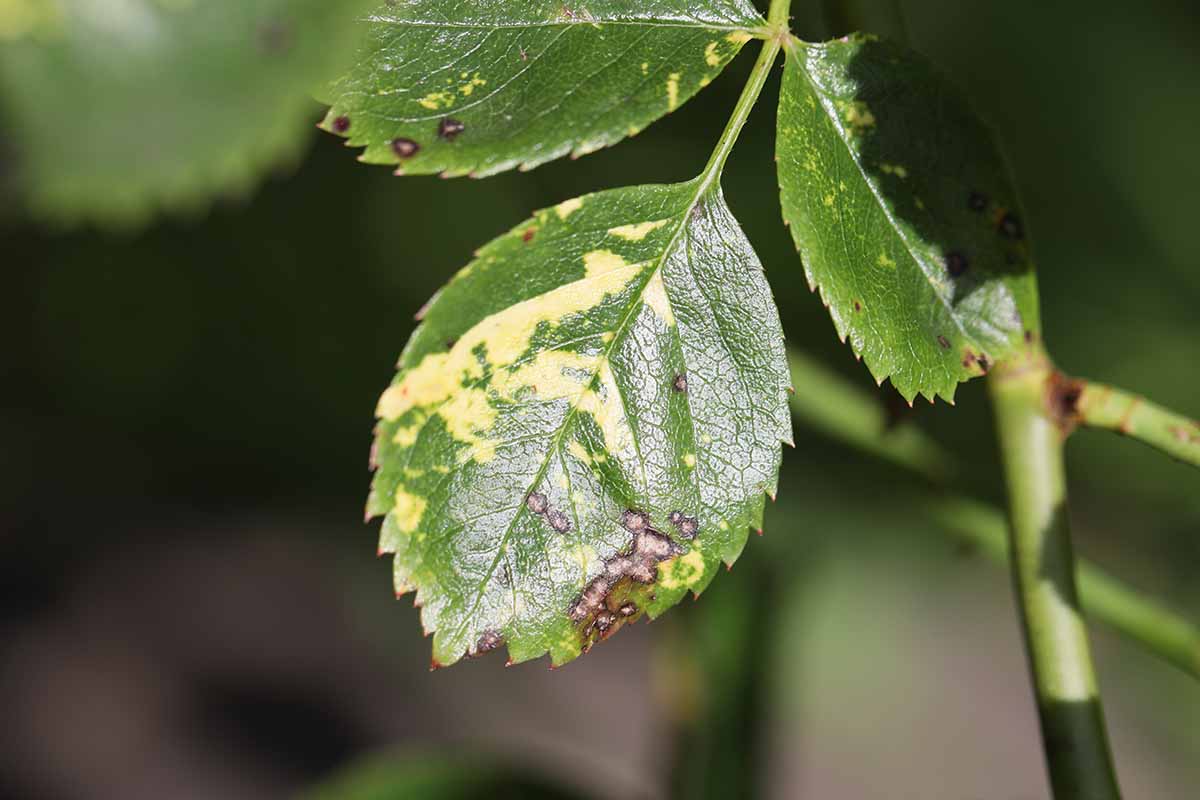
Evidence of infection typically only shows up in one section of the plant though the virus is systemic, meaning it will be present throughout the entire thing.
In addition to the unusual yellow pattern, the shrub may exhibit stunted growth, may have reduced blossoming or none at all, and might be more susceptible to frost damage, with deadened stems or brown foliage after a frost.
Some plants might be killed entirely after a particularly cold winter.
How RMVc Spreads
Fortunately, this disease doesn’t spread on tools and it isn’t transmitted by insects.
It gets around when breeders take grafts, cuttings, or budding from infected plants. The bad news is that the symptoms might not show up for years, and it often doesn’t show up at all until after a rose is planted into the garden.
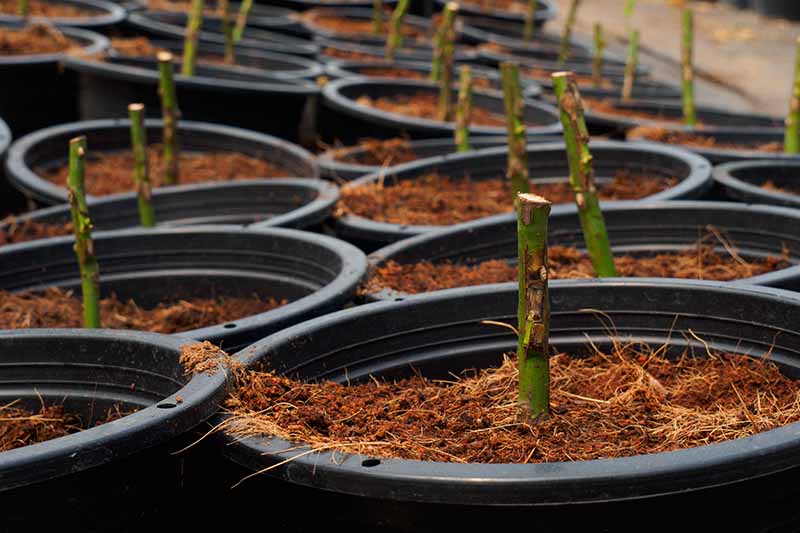
That means breeders could be using an infected potted plant for a breeding program without even knowing it.
Testing is available to help figure out if a plant is carrying the disease, but home breeders and smaller operations can’t necessarily afford to check every new creation, and some larger breeders don’t go to the effort.
The virus can be spread via pollen in other species, but this doesn’t appear to be the case with roses. We do know that it doesn’t spread from plant to plant in a garden setting.
How to Treat It
There’s no cure or effective treatment for RSVc. You can prune away the ugly parts, but it won’t reduce the infection. This just makes the infected plant look prettier for the time being, until new symptoms develop on other parts.
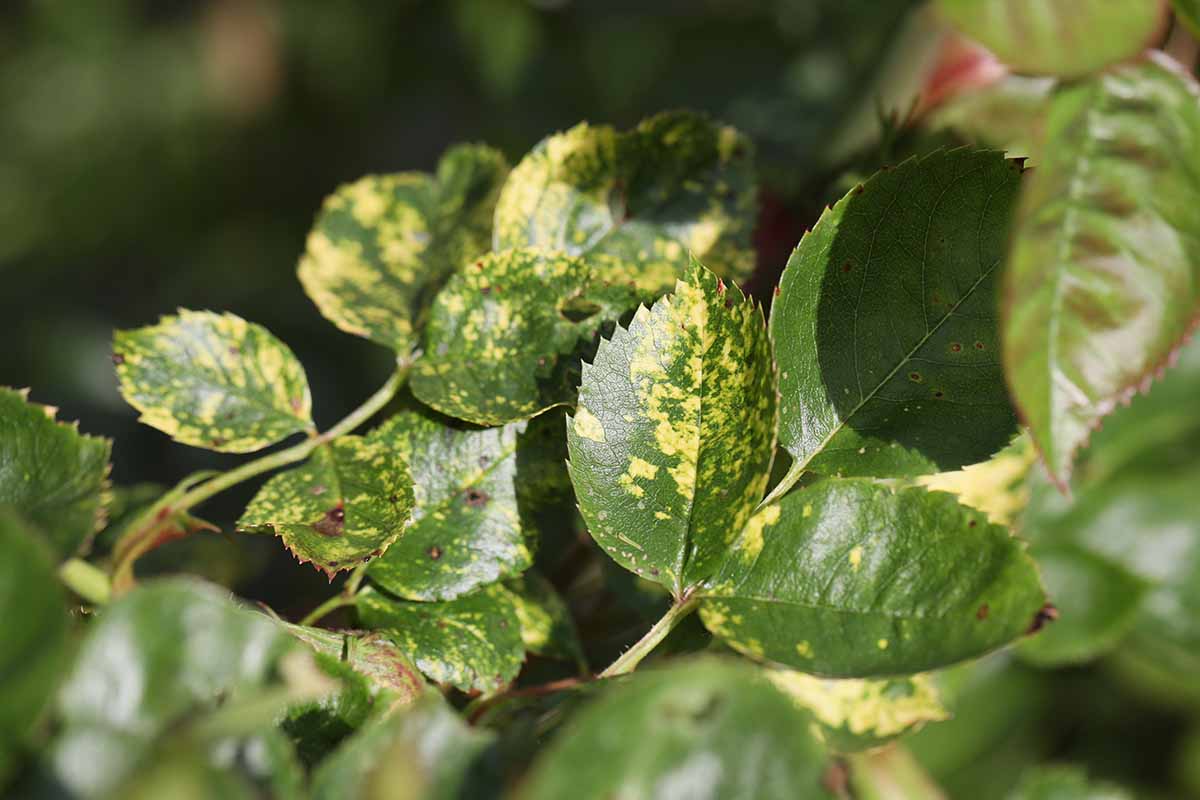
If an ailing plant that you’re growing is too weak, doesn’t flower well, or is consistently damaged by frost, it’s probably best to pull it and buy a new plant.
The good news is that you can buy certified disease-free plants. Just look at the label. Growers who test are proud to show off their safe practices, so they’ll make sure to include that info on the label.
Rose Mosaic Isn’t Pretty
It sucks when your favorite plant comes down with RMVc.
With no cure, it means you might have to say goodbye to a cherished shrub. Even worse, you won’t even be able to take a cutting to try and reproduce a beloved plant because this will just spread the disease.
But you might just be able to live with it, and when you purchase plants in the future, just make sure they’re certified RMVc-free.
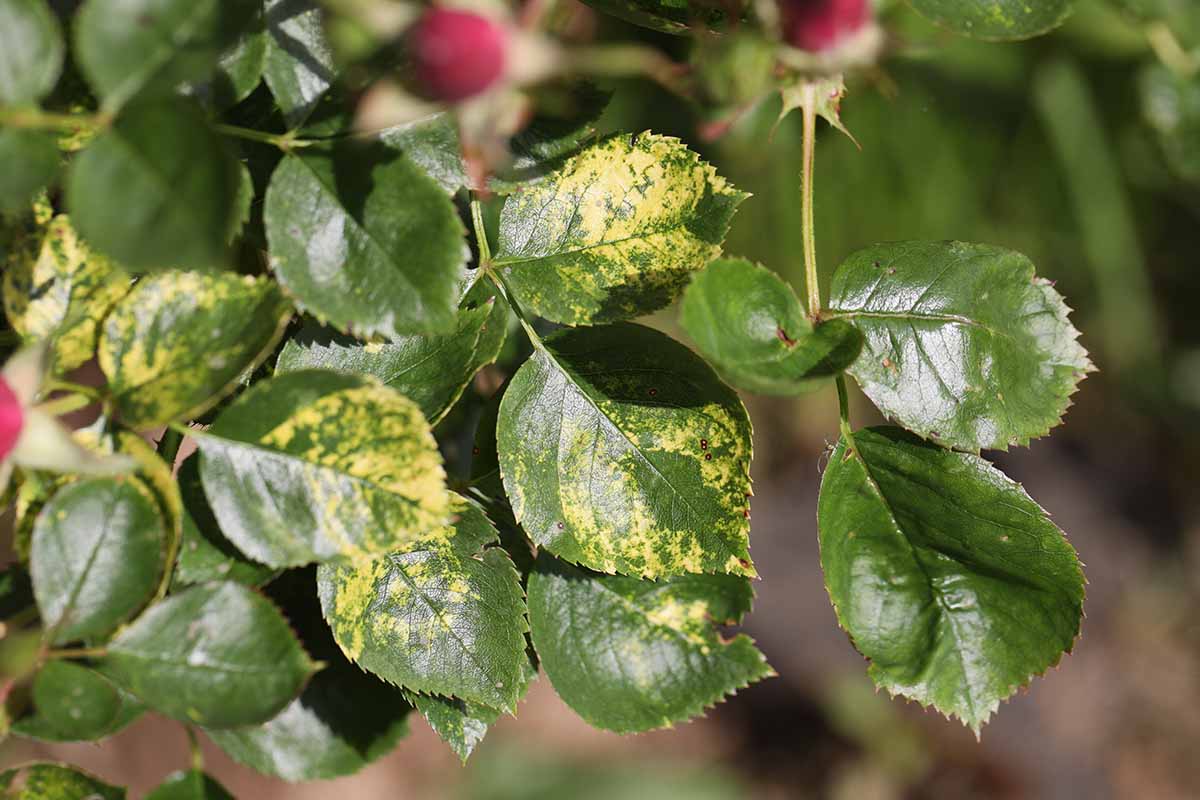
Are you dealing with this disease in your garden? What symptoms are you seeing on your plants? Let us know in the comments.
We hope this guide set you in the right direction for improving your garden. If so, you might be interested in a few of our other rose growing guides, such as:

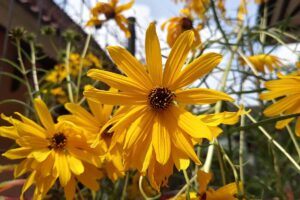

Can you plant a new bush where the infected one was?
You sure can. It won’t spread to the new rose through the soil. That’s one of the few good things about rose mosaic virus!
My ‘Queen of Sweden blooms’ great in spring but I never get a rebloom. Could mosaic be the reason?
Hi Jim, is the plant showing any other signs of mosaic apart from failing to rebloom? Could you upload a picture so we can take a look? Thanks!
We inherited a modest rose garden when we bought our current home and now I finally know what’s wrong with the one rose bush that remains short and puts out fewer blooms! Thank you for the insight, at least I don’t have to dig it out with haste and can focus on the rust emerging a few roses over. :/
Glad we could help!
I have a rose that bloomed beautifully last year, I thought I had just right conditions for the rose—but this year, on several rose plants the leaves look like all the chlorophyl has been sucked out of each leaf. They are not turning yellow or have spots, they are ashen brown looking—-without any green on the leaves and it’s spreading to all my roses—- can you help me?
Hi Theresa, I’m sorry to hear that. Can you give me a little more information or pictures? Brown leaves can be a sign of many different causes. Is the brown somewhat lacy looking, with patterns throughout? Are they dry and crumbly or thick and wet? If you examine the plant closely, do you see any fungal growth on the leaves, canes, or near the ground? Let me know and I’d be happy to help.
I think you have diagnosed my rose bush! It is an old, large, vigorous lady that blooms like mad (for now). But, yep, funky leaves appear scattered in clumps throughout. Learning that it is incurable is especially difficult today, as this morning I dug up and threw away a young rose bush that had rose rosette disease. It is good to know this old girl isn’t a danger to her neighbors and can stay and live out the rest of her days right where she is.
Hi Heather, except for the mosaic, that rose looks as healthy as can be! I have several roses that lived long, happy lives with the disease, and hopefully yours will too.
My rose has similar yellow patches and based on this article I belive it is mosaic virus, and mostly at the lower part for several weeks now. But the upper part has recently developed leaves with block dots. I’m not sure if this is the same mosaic virus or something else? But, overall it is blooming almost fine. I’m in S California Zone 10. I appreciate any input & advise. Please see photos.
Hello Mo, this actually looks like black spot, not mosaic. It’s a pretty common disease and one I deal with most years on my roses. We have a guide to walk you through how to deal with it.
Someone suggested this might be blackspot or rust. Said to maybe try a spray of baking soda in water or with a spray containing Mancozeb. I can’t tell if it is one of those issues or rose mosaic. Your thoughts?
Hi Helen, it looks like you have a few things going on here. You certainly do appear to have mosaic, but the spots on the leaves with tan centers indicate anthracnose. It’s caused by the fungus Sphaceloma rosarum and travels in water, which is why overhead watering should be avoided. Prune off the symptomatic leaves and spray the remaining plant with mancozeb or copper fungicide. The black fungal spores look like sooty mold to me, which indicates that you might have aphids. Can you wipe the black mold off? Do you see any aphids, which usually cluster on the buds?
Hello! I love roses, but I’m new to this. Single rose leaves look like in the photo. I think it looks like the description from your guide .(((
Hi Svitlata, I’m not convinced this is rose mosaic. It looks like it could be downy mildew. We have a guide that will walk you through identifying and treating downy mildew. Give it a look and see if the rest of the symptoms fit what you’re seeing on your rose.
After reading this article I feel sure that a rose I have just purchased on line has the virus. The company claim it hasn’t and will be healthy . Just take the leaves off they say. However on further emails they claim they can see some similarities to Rose Mosaic virus. Just wondered how you felt about these photos please?!
Thanks.
Hi Charlotte, if I had to bet, I would put money on this being rose mosaic. The pattern on the leaves is pretty classic mosaic. As you know, removing the leaves won’t eliminate the disease.
What rose are you growing? The image on the tag looks similar to the flowers on my ‘Olivia Rose Austin.’ If that’s what you’ve got, enjoy (and hopefully the company will replace it with a new plant)! It’s one of my favorites, the blossoms are out of this world.
I think I just found out why my rose leaves have taken on this coloring. It’s only two years old and I purchased it from Home Depot. It seems fine otherwise. The other two bushes are not showing any symptoms. I’m wondering if I should just let it die naturally or dig it up and discard it? I am also fighting black spot. I’m almost to the point where I just want to do away with the roses and use the space for something less troubling. I just bought a miniature knock out rose and it’s now showing black spot… Read more »
Hi Anthony, that definitely looks like mosaic virus. I hear you, roses can be a pain and if you aren’t just in love with them, there are lots of other options. But if you love roses, like I do, they’re worth the battle. You can use copper spray to deal with the black spot and you can leave the plant if you don’t mind the unusual leaves. The virus might spread to other plants, so tear it out if you don’t want to risk that.